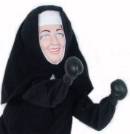 Now it looks to me as if my fighter pens might be part of a longer tradition:
Now it looks to me as if my fighter pens might be part of a longer tradition:
If you google for boxing puppets, the one that comes up most often is the Punching Nun. I suppose there is something intrinsically funny about peacable or unlikely figures fighting. The punching nun and similar puppets – and there are a bunch of them – are bigger than the fighter pens, being about 30cm tall. They also have a springy neck so that they appear to duck and weave as they box. I haven’t seen one to look at closely, but here is a nice discripton from American Science and Surplus:
‘Maggie In A Habit
AKA “The Fighting Nun”. A nun puppet in full habit with two arms ending in boxing gloves. The puppet is mounted on a stick which you can hold in your hand (dare we say under her habit??) leaving two fingers free to work the controls for the spring mounted arms. A flick of the finger and she unleashes a swift left or right jab, fighting for the right!! We know she is fighting for the right, because under the habit is the face of Maggie Thatcher, as you can tell if you peek. Seems a manufacturer got stuck with the doll mold and a zillion heads just when she was ousted as PM. An entrepreneur bought up the works and created the fighting nun. Somehow, we think Maggie would approve. As will you.’
Where you find the Punching Nun, you are likely to also find these versions: the Devil, a Rabbi, and an Amish, and, less commonly, skeleton, alien, dinosaur, and kangaroo punching puppets. There are also a couple of punching puppets related to the “Lunar” gaming series, anime figures called Ghaleon and Alex (links not available anymore). And these punching puppets are being sold as items to go in a photographer’s bag of tricks to make people smile. Perhaps they are Moe and Curly from The Three Stooges?
The Punching Abe Lincoln puppet is not the only punching politician. Here is Ronald Reagan duking it out with Mr.T. Mr. T and Rocky from the film Rocky III appear as a set, too.
Going back further, it looks as if this idea may have originated with puppets of real boxers. A few weeks ago Ebay sold a set of Mohammad Ali and Howard Cosell boxing puppets for US$19.99, described as follows:
“The puppets have a company logo that appears to be the letters S.Y.C. (the Y might be a V) inside an oval, and they are marked Made In Hong Kong. I cant find a date on these toys, but they appear to be younger versions of both men. They are wearing boxing gloves and have on red robes with white rope sashes. Iside the robes are two levers to control the punching action. Both of these puppets are in excellent condition, with very little, if any wear, although there is a bit of on the ends of the rope sashes. The boxing action on both puppets is in great working condition. As stated above, I am not sure of the name of the manufacturer of these puppets or when they were made, but if you are a boxing fan and remember the friendly antagonism between Ali and Cosell, you should appreciate and value these unique collectibles.”
And at Mr.Punch’s Old Toys, there is a 1970’s African-American boxer punching puppet, ‘undoubtedly inspired by boxing legends such as Ali and Frazier’.
And what directions for the future of punching puppets? The Character Shop mentions the Duracell boxers characters created for a Duracell commercial, which have animatronic movements of heads and arms.
And The Intelligent Machines Design Lab has a page of final papers decribing an intreguing range of robots. One of these details ‘Sister Roboto’, a robot designed by Phillip Thomas, which uses a punching nun mechanism which has ‘servos to position it for optimal punching’. ‘It seeks out targets in need of a pummeling and attempts to destroy them by punching them repeatedly until they are knocked over’. If she is successful in knocking over her target ‘ she celebrates by spinning around, if she is unsuccessful she shakes back and forth’ before moving on the find another target.’

 Now it looks to me as if
Now it looks to me as if 

